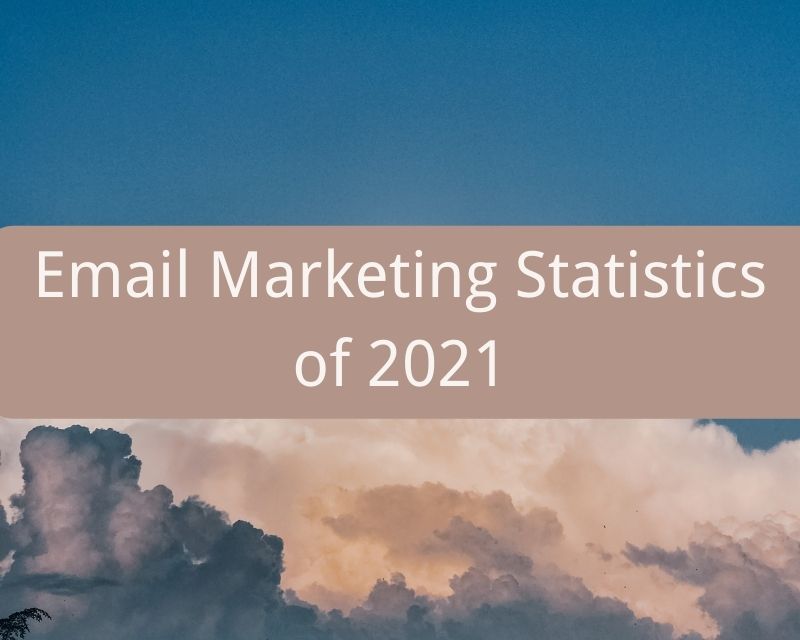2021 has passed three quaters. There is only one quater left. You have already run a large number of email marketing campaignes, but did you review the email marketing statistics in this year? Let’s go and get to learn some below.
Nowadays, marketers place great emphasis on webinars, video events, and other new opportunities to reach customers.
But your contemporary communication methods shouldn’t distract you from one of the oldest but most effective messaging channels – email.
You may be wondering if the email is still a worthwhile marketing strategy. Well, it is.
In fact, email generates $36 for every $1 spent, which is a staggering 3,600% ROI, making it one of the most effective options available.
If you’re still hesitant, keep reading — we’ve cultivated a list of email marketing statistics for 2021 to demonstrate just how powerful email can be.
General Email Marketing Statistics and Best Practices
The global e-mail marketing market was valued at $7.5 billion in 2020 and is projected to increase to $17.9 billion by 2027. (Statista, 2021)
There are 4 billion daily email users. This number is expected to raise up to 4.6 billion by 2025. (Statista, 2021)
More than 306 billion emails are sent and received each day. (Statista, 2021)
Active email accounts surpassed 5.6 billion in 2019. (Statista, 2019)
64% of small businesses use email marketing to reach customers. (Campaign Monitor, 2021)
Since the pandemic, more than 40% of marketers have cut their email budgets. (Litmus, 2020)
Across all industries, the average email open rate is 19.8%, the click-through rate is 11.3%, and the bounce rate is 9.4%. (Constant Contact, 2021)
Marketers who used segmented campaigns noted as much as a 760% increase in revenue. (Campaign Monitor, 2019)
4 out of 5 marketers said they’d rather give up social media than email marketing. (Litmus, 2020)
35% of marketers send their customers 3-5 emails per week. (Not Another State of Marketing, 2020)
78% of marketers in 2020 said email is important to overall company success, compared to 71% in 2019. (Litmus, 2020)
78% of marketers have seen an increase in email engagement over the last 12 months (Not Another State of Marketing, 2020)
31% of B2B marketers say email newsletters are the best way to nurture leads. (Content Marketing Institute, 2020)
The U.S. spent over 350 million dollars on email advertising in 2019. (Statista, 2019)
Brands that always include an A/B test in their emails generate an ROI of 48:1. (Litmus, 2019)
Globally, Fridays see the highest email open rates (nearly 19%), compared to the lowest open rates (17%) on Saturdays. (Campaign Monitor, 2021)
66% of marketers believe artificial intelligence is a way to optimize email send times. (Statista, 2019)
23% of brands have already experimented with interactive elements in email, an additional 32% are planning on trying it soon. (Not Another State of Marketing, 2020)
B2B Email Marketing Statistics
81% of B2B marketers say their most used form of content marketing is email newsletters. (Content Marketing Institute, 2020)
16% of all emails never make it into the inbox. (Email Tool Tester, 2019)
On average, B2B companies send one email marketing campaign every 25 days. (SuperOffice, 2020)
31% of B2B marketers say email newsletters are the best way to nurture leads. (Content Marketing Institute, 2020)
87% of B2B marketers say email is one of their top free organic distribution channels. (Content Marketing Institute, 2020)
90% of content marketers say email engagement is the top metric they track to measure content performance. (Content Marketing Institute, 2020)
89% of all B2B email campaigns are sent from a company name. (SuperOffice, 2020)
The second-most common technology B2B organizations use to assist with content marketing is mail marketing software. Roughly 85% of marketers say they work with these tools. (Content Marketing Institute, 2020)
Mobile Marketing Statistics
Nearly 55% of global website traffic is generated from mobile devices, excluding tablets. (Statista, 2021)
Apple iPhone’s native email app has the highest market share, followed by Gmail. (Litmus Labs, 2021)
Nearly 1 in 5 email campaigns is not optimized for mobile devices. (SuperOffice, 2020)
Launching a mobile-responsive email design can increase unique mobile clicks by 15%. (MailChimp, 2019)
Mobile-friendly email is the second most-used tactic email marketers to improve their performance. (HubSpot, 2020)
9.3% of email clicks come from tablets, rather than smartphones or computers. (MailChimp, 2019)
Although people primarily check email on iPhone devices, Gmail is still the most-used email service, with more than 1.5 billion users (CNBC, 2019)
B2C Email Marketing Statistics
Your audience will reward you with higher open and click rates if you don’t send more than five newsletters a week. (GetResponse, 2020)
60% of retail, e-commerce, and consumer goods and services companies are personalizing emails based on past purchases, versus 38% in 2019. (Litmus, 2020)
More than 8 out of 10 people will open a welcome email, generating 4x as many opens and 10x as many clicks as other email types. (GetResponse, 2020)
The single message autoresponder email had an astonishing 98% open rate and a 37% click-through rate. (GetResponse, 2020)
Nearly 22% of all email campaigns are opened within the first hour of sending. (GetResponse, 2020)
45% of internet users avoid opening emails from unknown addresses. (Statista, 2019)
Email Marketing Demographics 2021
99% of email users check their inbox every day, with some checking 20 times a day. Of those people, 58% of consumers check their email first thing in the morning. (OptinMonster, 2020)
40% of consumers say they have at least 50 unread emails in their inboxes. (HubSpot, 2020)
Emails sent by independent artists, writers, and performers have the highest open rate at 34.4%, followed by education (34.1%) and travel and tourism (32.6%). (Constant Contact, 2021)
On average, the highest email click-through rate goes to the Consulting services industry at 25%, with Administrative and Business Support services in second at 20%, and Home and Building services in third at nearly 19%. (Constant Contact, 2021)
26% of retail emails bounce, putting it well above the 9% average bounce rate for all industries. (Constant Contact, 2021)
20% of retail, e-commerce, and consumer goods and services companies are personalizing emails based on gender, race, ethnicity, versus 11% in 2019. (Litmus, 2020)
59% of Millennials primarily use their smartphone to check email, while 67% of Generation Z scans their inbox on mobile. (Bluecore, 2021)
74% of Baby Boomers think email is the most personal channel to receive communications from brands, followed by 72% of Gen X, 64% of Millennials, and 60% of Gen Z. (Bluecore, 2021)
91% of women in the US use email, compared to 89% of men. (Statista, 2019)
Asian Americans are the most popular email users in the US (92%), followed by white users (91%), African American users (88%), Hispanic users (85%), and American Indian or Alaskan Native users (83%). (Statista, 2019)
In conclusion
Briefly, email marketing still plays an important role in business marketing. If you have a good sense of email marketing statistics, then you get the key to increasing the email campaigns conversion.




